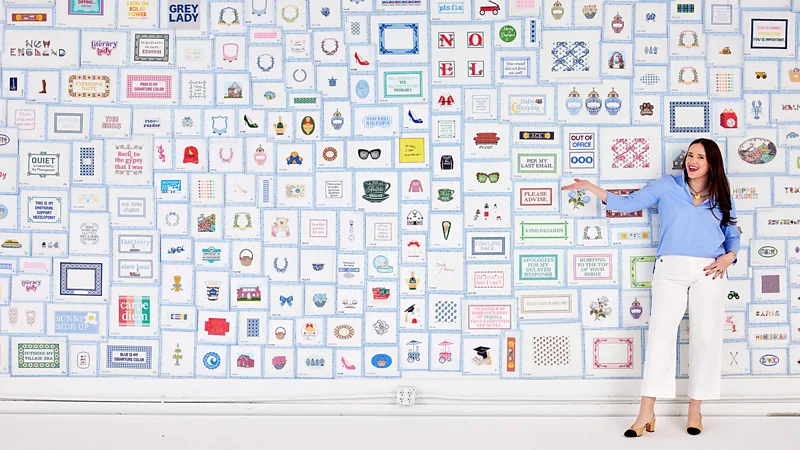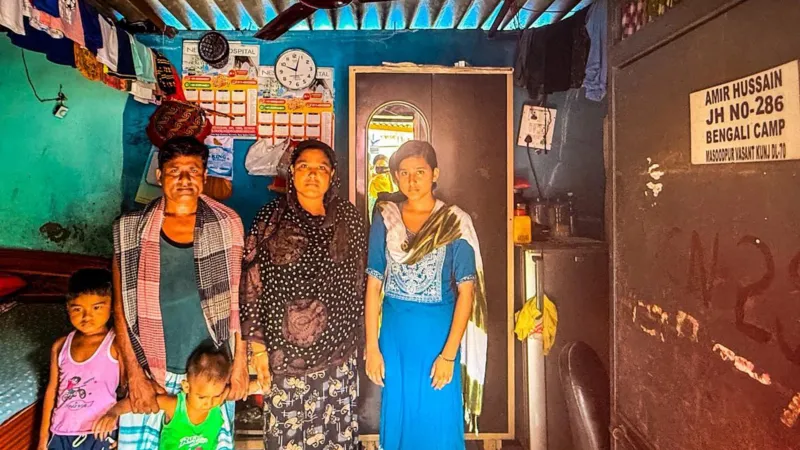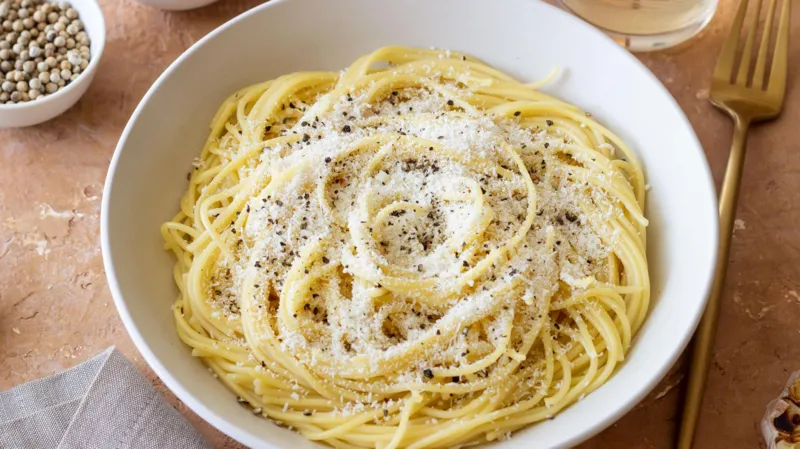The historic, aristocratic craft loved by Taylor Swift that's making a surprising comeback
Beloved by European royals and aristocrats – and recently seen on screen in Bridgerton – the traditionally fusty craft of needlepoint is increasingly popular with Gen Z and young millennials.

The Featherington women of Bridgerton love it, Taylor Swift loves it – and in recent years it has gained a huge following among young Millennials and Gen Z. It's no secret that the Covid-19 pandemic sparked a revived interest in arts and crafts of all kinds, from knitting and crocheting to sewing and soap-making, as those of us stuck indoors sought out hobbies to occupy our hands and soothe our minds. But perhaps most surprising of all the pursuits to take hold during this time was needlepoint – that historic craft, formerly associated with royals and aristocrats, and perhaps your grandmother's floral cushion covers – which gained extraordinary traction among millennials during the lockdown period. And its popularity is showing no signs of slowing down: according to various needlepoint retailers, the craft has recently taken off on TikTok too, attracting a new wave of Gen Z practitioners in 2024.
So what is it about needlepoint, a practice with a famously fiddly, somewhat fusty reputation, that's so appealing to a modern audience, and who are some of the creatives and companies fuelling its revival?
To start with, it's important to understand what differentiates needlepoint from other forms of needlework. In the UK, for instance, needlepoint is frequently referred to as "tapestry" – a term that, according Dr Susan Kay-Williams, Chief Executive of the Royal School of Needlework (RSN), is "technically incorrect".
"Needlepoint, or canvaswork as we call it at RSN, is a specific type of embroidery," Kay-Williams tells BBC Culture. "In proper tapestry, you begin with the warp threads and create both the fabric and the picture with the weft threads that go across. In embroidery, you always have a base fabric, known as a ground fabric, and there are different types depending on what kind of stitching you're doing," she explains.
Stitch clubs populated by millennials and Gen-Zs have cropped up all over the United States and beyond
What separates needlepoint from other forms of embroidery is its ground fabric – a canvas grid, made up of small square holes that must be entirely stitched – and the fact that it can only be done by hand. "What you're trying to do is to fill all the canvas holes with thread, whether that's the foreground – the pretty bit – or the background," says Kay-Williams. "You don't leave the ground fabric showing at all. So needlepoint requires a lot more work, but it is also hard-wearing as a result, hence there are so many historic examples of it preserved."
Two types of wool thread are most commonly used for canvaswork, alongside silk or stranded cotton for detailing, Kay-Williams continues: thicker tapestry wool and thinner crewel wool, with which "you can blend colours by having more strands in your needle at one time". While the most popular among the many needlepoint stitches is the diagonal tent stitch, which she describes as going in one direction "like hatching".
Needlepoint has a wide-reaching history that can be traced as far back as 1500 BC to ancient Egypt, where, as evidenced by hieroglyphic renderings and artefacts retrieved from tombs, a slanted stitch technique was employed to adorn clothing and religious objects. It wasn't until the 16th Century that the practice found popularity in Europe, thanks to the invention of the steel needle, which enabled tapestry-like pieces to be woven by hand. Soon needlepoint was being used to create furniture upholstery and wall hangings by professionals and amateurs alike. In Elizabethan England, it became a favourite pastime of nobles and royalty. Mary Queen of Scots was a famously prolific needlepointer, undertaking many works during her imprisonment by her cousin, the queen.
The craft has retained its royal connection in the UK in the centuries that have followed. The Royal School of Needlework, founded in 1872 by Lady Victoria Welby, boasted Queen Victoria as a patron. And the entire family of King George VI, Victoria's great-grandson, were avid needlepointers, Kay-Williams says – from the King himself, who learned to stitch while serving in the Navy, to his wife Mary and their sons: "I read an article from the 1930s in a Sheffield newspaper titled 'The Stitching Royal Family'."
So how did this once-royal pursuit – an endeavour that takes skill, stamina, and patience to achieve, and yields chair covers and intricate wall decor – find itself the 21st Century's latest crafts trend, practised by Taylor Swift, Julia Roberts, Amy Adams and many more?
"I think it definitely came out of lockdown," Kay-Williams confirms. "There was a resurgence of embroidery as a whole, and needlepoint is a good place to start because the holes on the canvas help guide you. Also, there's something very meditative about the repetition of needlepoint stitching," she adds. "During the World Wars, returning soldiers and sailors were often given stitching, and particularly needlepoint, to help them recover from shellshock. While they focused on the stitching, other parts of the body or mind could heal. I believe the mindfulness aspect of it remains key today."
I look at needlepoint as something that reduces my anxiety, and lets me really sit with my own thoughts – Krista LeRay
This is a view shared by Krista LeRay, a needlepoint content creator with over 150K TikTok followers, who founded popular online needlepoint store Penny Linn Designs from her New York City apartment in 2020. "I think it has a lot to do with the fact that people were looking for ways to get off their phones, to get away from the news – which many of us are still," she tells the BBC, describing the boom that kick-started, and has sustained, her business. "I have ADHD, and I look at needlepoint as something that reduces my anxiety, and lets me really sit with my own thoughts."
"For me, it gives a sense of control," says Jessica Chaney, owner of Lycette Designs, a contemporary needlepoint store in Palm Beach, Florida whose sales soared during the pandemic, and again at the start of 2024 as needlepoint began to trend on TikTok. "It's like power washing, filling the canvas. And of course there's the creativity, the colour, the sense of achievement when you finish a piece," she tells the BBC.
Interestingly, for a solitary craft, both women allude to the strong sense of community that needlepoint has fostered among its younger practitioners. "During Covid, a lot of people were connecting over Zoom to stitch, because it's something you can do while chatting and it was a way of being together," LeRay notes.
Since then, stitch clubs populated by Millennials and Gen-Zs have cropped up all over the United States and beyond, while social media content makers, including LeRay and Chaney themselves, have attracted thousands of followers keen to learn from their tips and tutorials. "TikTok has opened a door into learning about needlepoint in a way that seems more accessible," Chaney explains. "Older store owners typically expect you to come in and know exactly what you’re doing, so the videos that we've had the most popularity with are ones explaining what fibre or canvas to use, and how to finish. And perhaps that's why more young people feel empowered to try it."
Penny Linn and Lycette Designs sell hand-painted canvases that are very much geared towards this new generation of needlepointers – including playful pictures of everything from food to flamingoes, and pithy statements like "Mom, I am a rich man" (the inimitable Cher quote) and "maid wanted". "I find that the younger needlepointers have that irreverent sense of humour, where they're not afraid to stitch something that would make Grandma clutch her pearls," says Chaney.
Traditional with a twist
"Needlepoint works really well with typography because of its pixelated quality," explains Izzy Hunt, one half of British fabric house Hunt & Hope, makers of bespoke hand-stitched needlepoint for the home. Like the Royal School of Needlework, which recently launched the RSN Stitch Bank, an expanding digital archive of stitches that is ongoing, in a bid to preserve and revive historic techniques, Hunt & Hope is determined to uphold needlepoint tradition. The brand set up shop in 2017, partnering with a women-led workshop of stitchers in Madagascar for the purpose, with the express intention of "injecting this ancient craft with brilliant colours and contemporary patterns".
"We wanted to change people's mindsets about needlepoint," Hunt's co-founder Emmie Hope tells the BBC. "You really can do anything with it, so it was about trying to educate people and inspire them to add this wonderful fabric somewhere else in their house beyond their sofa cushions." And they have achieved just that, garnering acclaim among interior designers and private clients alike. (They've recently done a roaring trade in Christmas stockings, Hope says, each stitched with pictures relevant to its owner, highlighting needlepoint’s potential for personalisation – another major draw.)
"I love how needlepoint can be used to create a variety of items," agrees Miharivola Andriambinintsoa, a Malagasy artisan who works with Hunt & Hope. "It's simple but it can be challenging," she tells the BBC. "It requires skills that not all craftspeople possess." Her tips? "Stay focused and follow the chart carefully. It's easy to make mistakes, but with attention to detail, you can create beautiful designs."
"My advice is just start, and enjoy yourself," Candace Bahouth, an artist and successful needlepoint canvas designer for arts and crafts supplier Ehrman, tells the BBC. "And don't be too tight with your stitches." Hope concurs, stressing that a needlepoint frame is essential to stretch the canvas and regulate your stitching, plus a comfy chair and good lighting.
When it comes to choosing a canvas, Chaney suggests starting with a simple 13-mesh grid, comprising only a few colours, while LeRay similarly recommends purchasing a keychain beginner kit, with two thread colours, as a means of testing whether needlepoint is for you.
At around £50 on the Penny Linn site, these aren't cheap. "Needlepoint does have a higher barrier to entry, because it's all entirely handmade," LeRay explains. "Even the threads we sell are hand-wound." But there are workarounds, Chaney notes, such as buying canvases on eBay or Etsy, or securing blank ones that you can paint yourself.
Hunt & Hope/ Kalina Krawczyk The slow, methodical processes behind needlepoint appeal to all age groups, according to practitioner Emmie Hope (Credit: Hunt & Hope/ Kalina Krawczyk)Hunt & Hope/ Kalina Krawczyk
The slow, methodical processes behind needlepoint appeal to all age groups, according to practitioner Emmie Hope (Credit: Hunt & Hope/ Kalina Krawczyk)
And, of course, whether you’re stitching to make a statement or make friends, to calm your thoughts and feel more mindful, or to craft something expressive of your personality, the slow, manual processes behind needlepoint are surely its biggest charm for practitioners of all ages and genders.
"There's this incessant need for speed these days," says Hope. "I remember when we set up Hunt & Hope, a wonderful, wise old friend said: 'You've got to make the word slow a good word.' Because needlepoint is methodical, it is a slow process, but it looks fabulous and it lasts forever."
-bbc






